National emblem of France
| Emblem of the French Republic | |
|---|---|
 | |
| Details | |
| Armiger | French Republic |
| Adopted | 1912 |
| Escutcheon | Or, the letters R and F conjoined Or. |
| Emblem of the French Republic | |
|---|---|
.png) | |
| Details | |
| Armiger | French Republic |
| Adopted | 1905 |
| Escutcheon | Azure, a Fasces surrounded by on the dexter, a wreath of laurel, and to the sinister, a wreath of Oak, over all a ribbon bearing the legend 'Liberte, Egalite, Fraternity', all Or. |
| Orders | Collar of the Legion of Honour |
The French Republic currently uses two emblems. One has been a symbol of France since 1912, although it does not have any legal status as an official coat of arms. It appears on the cover of French passports and was adopted originally by the French Foreign Ministry as a symbol for use by diplomatic and consular missions using a design by the sculptor Jules-Clément Chaplain.
In 1953, France received a request from the United Nations for a copy of a national coat of arms to be displayed alongside the coats of arms of other member states in its assembly chamber. An interministerial commission requested Robert Louis (1902–1965), heraldic artist, to produce a version of the Chaplain design. This did not, however, constitute an adoption of an official coat of arms by the Republic.
It consists of:
- A wide shield with, on the one end a lion-head and on the other an eagle-head, bearing a monogram "RF" standing for République Française (French Republic).
- A olive branch symbolises peace.
- An oak branch symbolises perennity or wisdom.
- The fasces, a symbol associated with the exercise of justice (the bundle of rods and an axe were carried by Roman lictors). This use of the fasces predates the adoption of this symbol by Benito Mussolini as the emblem of Italian Fascism.
In September 1999, the French government adopted a unique official identifier for its communication, incorporating the Republic's motto, the colours of the flag, and Marianne, the Republic's personification.
 The symbol is used on plaques marking French consulates.
The symbol is used on plaques marking French consulates.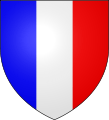 Shield on the Senate entrance.
Shield on the Senate entrance..svg.png) Fleur de Lys, a popular symbol during monarchical times, today used mostly by overseas people of French heritage, like the Acadians, Québécois or Cajuns.
Fleur de Lys, a popular symbol during monarchical times, today used mostly by overseas people of French heritage, like the Acadians, Québécois or Cajuns. Sometimes used on a semi-official basis, but having no official status as the arms of the French Republic.
Sometimes used on a semi-official basis, but having no official status as the arms of the French Republic.
History
The historical coat of arms of France were the golden fleurs-de-lys on a blue field, used continuously for nearly six centuries (1211-1792). Although according to legend they originated at the baptism of Clovis, who supposedly replaced the three toads that adorned his shield with three lilies given by an angel, they are first documented only from the early 13th century. They were first shown as semé, that is to say without any definite number and staggered (known as "France ancient"), but in 1376 they were reduced to three, (known as "France modern"). With this decision, King Charles V intended to place the kingdom under the double invocation of the Virgin (the lily is a symbol of Mary), and the Trinity, for the number. The traditional supporters of the French royal arms are two angels, sometimes wearing a heraldic dalmatic.
| Coat of arms | Description and blazon | Dates used |
|---|---|---|
 |
Flags and coats of arms based on this banner were mostly used during the Early Middle Ages and medieval times of the Carolingian Empire, first introduced by Charles the Great. Oriflamme (from Latin aurea flamma, "golden flame") was the battle standard of the Kings of France. It was originally the sacred banner of the Abbey of St. Denis, a monastery near Paris. | Frankish Empire |
.svg.png) |
The arms of "France Ancien": Azure semé-de-lis or | Before 1305 |
.svg.png) |
Arms of "France Ancien" dimidiated with the arms of Navarre, after king Louis X inherited Navare from his mother Joan I of Navarre in 1305. | 1305–1328 |
.svg.png) |
The arms of "France Ancien": Azure semé-de-lis or. After the death of the last direct Capetian in 1328, the kingdom of France passed to the house of Valois through the Salic law, and Navarre passed to the house of Evreux through female line. | 1328–1376 |
.svg.png) |
The arms of "France Moderne": Azure, three fleurs-de-lis or, a simplified version of France Ancien | 1376–1469 |
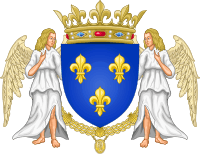 |
The arms of France Moderne. After the creation of the Order of Saint Michael in 1469, its collar was added to the royal arms. | 1469–1515 |
 |
The arms of France Moderne. King Francis I changed the open crown traditionnaly used by his predecessors for a closed one. | 1515–1578 |
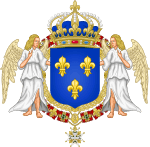 |
The arms of France Moderne After the creation of the Order of the Holy Spirit in 1578, its collar was added to the royal arms. | 1578–1589 |
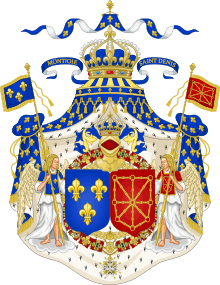 |
The royal arms of the Kingdom of France after the conclusion of the French Wars of Religion. Again the arms of the Kingdom of Navarre impaled with France Moderne, indicating the personal union of the two realms as a result of Henry IV becoming king. | 1589–1792 |
.svg.png) |
The arms of the First French Empire of Napoleon I, featuring an eagle and inset with "golden bees" as in the tomb of King Childeric I. | 1804–1814/1815 |
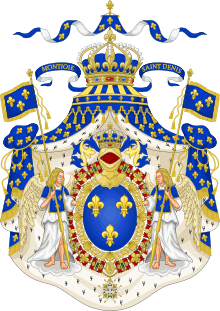 |
After the restoration the royal House of Bourbon once more assumed the French crown. | 1814/1815–1830 |
.svg.png) |
During the July Monarchy the arms of the House of Orléans were used. | 1830–1831 |
.svg.png) |
From 1831 onward, the arms of Louis-Philippe were used, depicting the Charter of 1830. | 1831–1848 |
 |
The Great Seal of the French Second Republic. | 1848–1852 |
-2.svg.png) |
The arms of the Second French Empire of Napoleon III, again featuring an eagle. | 1852–1870 |
 |
Unofficial Informal arms were created for the French Third Republic featuring fasces on a laurel branch and an oak branch in saltire. |
1898–1953 |
.svg.png) |
Unofficial Emblem of Philippe Pétain, chief of state of the French State (Vichy France), featuring the motto Travail, Famille, Patrie (Work, Family, Fatherland). The Francisque was only Pétain's personal emblem but was also gradually used as the regime's informal emblem on official documents. |
1940–1944 |
.png) |
Unofficial This composition, which was briefly seen in 1905 during the official visit to France of King Alfonso XIII, reappeared in 1922 in a cartoon by Gustave Jaulmes for a tapestry to be displayed in Strasbourg. In 1929, the French Ministry of Foreign Affairs replied to the German Embassy, which wanted to know the official coat of arms of the Republic, that, ″there is no, in principle, official coat of arms or emblem″, but that such a composition was used for the French embassies and consulates. The 1935 edition of Le Petit Larousse reproduced in black and white this composition as a symbol of the French Republic. In 1953, an inter-ministry committee chose it in order to meet the request of the United Nations Secretariat which wanted to adorn the assembly hall with panels reproducing the official coats of arms of each member state. |
1905, 1922/1953-present |
 |
Unofficial Informal arms dating from 1912, reintroduced during the presidency of Jacques Chirac (1995–2007) and still used. |
1912, 1953–present |
See also
External links
 Media related to Coats of arms of France at Wikimedia Commons
Media related to Coats of arms of France at Wikimedia Commons
